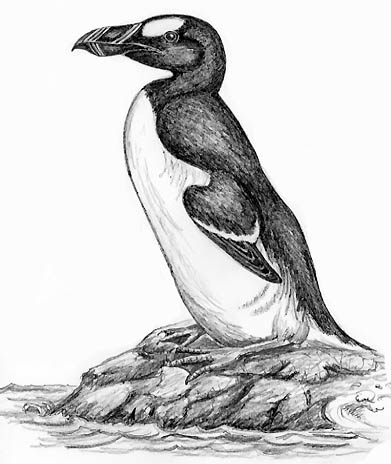
Dear Bird Folks,
I have been seeing posters around announcing a program at the Cape Cod Museum of Natural History entitled, “The Spirit of the Great Auk”. The posters made me laugh. Aren’t Great Auks those real stupid birds that people used to make fun of? Why would the Museum be having a program about the “spirit” of such a stupid bird?
-Jim, Eastham
Hang on Jimbo,
I’m sure I have mentioned this one other time, but with the exception of our brain-dead barnyard poultry, there are no “stupid” birds. Any creature that can build a nest or catch fish by just using its face has to have some brain power. And just so you know, the program at the Museum is about the Great Auk. The “stupid bird” you are thinking about is the “Dodo” bird. By the way, Dodos weren’t stupid either, they just had poor study habits.
The history of the Great Auk is interesting but a bit sad towards the end, so you might want to refill your Prozac if you plan to read on.
Although most of us are unfamiliar with them, auks are extremely abundant sea birds. They are typically black and white, found out in the ocean, look duck-like on the water and only come on land to breed. They walk like drunks and are shaky flyers, but are wicked good swimmers, using their wings to “fly” underwater. The puffin, with its odd punk-rock looking bill, is the most recognizable of all the auks.
Auks’ legs and feet are positioned closer to their tail so they are able to stand straight up, like a person. This is where the Great Auks stood out from the crowd. The Great Auk didn’t earn the name “great” because of any significant accomplishment, but because of its size. Standing nearly two and a half feet high, the Great Auk towered over other auks. A Great Auk basketball team would have easily dominated the other sea bird teams, except for the fact that the Great Auks had fouled out permanently, just before basketball was invented.
The Great Auk had such ridiculously small wings, compared to its giant body size, that there was no way it could fly. But the Great Auk wasn’t upset, it knew it was a superior swimmer. It could easily catch all the food it needed, had very few predators and didn’t smack into people’s windows like the other birds did. Things were going fabulously for North America’s only flightless bird until (stop me if you’ve heard this before) along came those wacky Europeans and messed things up.
Years ago, back when the Europeans had more on their minds than worrying about the Euro, they would explore the world looking for things to eat. Early European fishermen (I think it really was all men in those days) took full advantage of the juicy flightless auks. They would simply pull up to a nesting colony, herd thousands of defenseless birds onto the ship and turn them into auk cutlets. In a sad, but typical show of shortsightedness, adult birds were eaten, their young were used as fish bait and their eggs were scrambled or thrown at passing Viking ships on Halloween.
Great Auks mostly bred in the North Atlantic. They could be found wintering right here off the coast of Cape Cod. One of its major nesting colonies was near Newfoundland, on a place called “Funk Island.” Funk Island, of course, was named for all of those awesome parties that the birds had before the Europeans came.
By 1844 only two Great Auks and one egg remained on the entire planet. Not wanting to break with tradition, once discovered, those final two birds were immediately killed and the last egg smashed. The Great Auk was no more. Nice, eh?
The Great Auk was truly a unique bird, Jim, and its loss has left a void. But it should not be confused with the Dodo. And the Dodo should not be confused with anything that is stupid. We all know who deserves the title of stupid.